High Energy Stereoscopic System
High Energy Stereoscopic System (H.E.S.S.) is a system of Imaging Atmospheric Cherenkov Telescopes (IACT) for the investigation of cosmic gamma rays in the photon energy range of 0.03 to 100 TeV. The acronym was chosen in honour of Victor Hess, who was the first to observe cosmic rays.
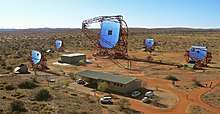 The five-telescope H.E.S.S. array | |
| Alternative names | H.E.S.S. |
|---|---|
| Location(s) | Khomas Region, Namibia |
| Coordinates | 23°16′17″S 16°30′00″E |
| Altitude | 1,800 m (5,900 ft) |
| Telescope style | telescope |
| Website | www |
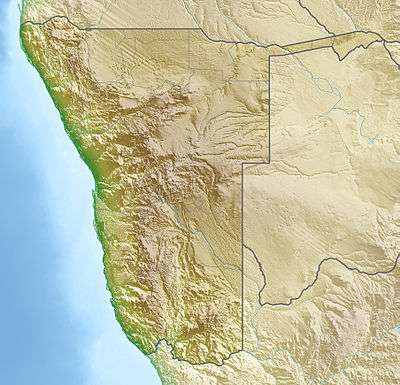 Location of High Energy Stereoscopic System | |
The name also emphasizes two main features of the installation, namely the simultaneous observation of air showers with several telescopes, under different viewing angles, and the combination of telescopes to a large system to increase the effective detection area for gamma rays. H.E.S.S. permits the exploration of gamma-ray sources with intensities at a level of a few thousandth parts of the flux of the Crab Nebula.
H.E.S.S. has five telescopes, four with a mirror just under 12 m in diameter, arranged 120 m apart from each other in a square, and one larger telescope with a 28 m mirror, constructed in the centre of the array. This current system, called H.E.S.S. II, saw its first light at 0:43 a.m. on 26 July 2012.[1]
As with other gamma-ray telescopes, H.E.S.S. observes high energy processes in the universe. Gamma-ray producing sources include supernova remnants, active galactic nuclei and pulsar wind nebulae. It also actively tests unproven theories in physics such as looking for the predicted gamma-ray annihilation signal from WIMP dark matter particles and testing Lorentz invariance predictions of loop quantum gravity.
H.E.S.S. is located on the Cranz family farm, Göllschau, in Namibia, near the Gamsberg, an area well known for its excellent optical quality. The first of the four telescopes of Phase I of the H.E.S.S. project went into operation in Summer 2002; all four were operational in December 2003.
In 2004 H.E.S.S. was the first IACT experiment to spatially resolve a source of cosmic gamma rays.
In 2005, it was announced that H.E.S.S. had detected eight new high-energy gamma ray sources, doubling the known number of such sources. As of 2014, more than 90 sources of Tera-Electronvolt gamma-rays were discovered by H.E.S.S.[2]
In 2016, HESS collaboration reported deep gamma ray observations which show the presence of petaelectronvolt protons originate from the supermassive black hole at central of Milky Way,[3] and therefore should be considered as a viable alternative to supernova remnants as a source of petaelectronvolt Galactic cosmic rays.
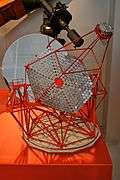 A 1/30 scale model of a H.E.S.S. telescope on display in the Science Museum, London.
A 1/30 scale model of a H.E.S.S. telescope on display in the Science Museum, London.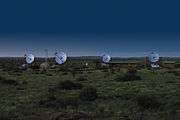 Four telescopes in operation at night
Four telescopes in operation at night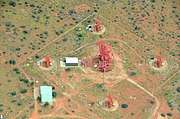 Aerial view of H.E.S.S. (2017)
Aerial view of H.E.S.S. (2017)
See also
References
- "Largest ever Cherenkov telescope sees first light". Retrieved 27 July 2012.
- Horan, Deirdre; Wakely, S. (2008). "TeVCat online catalog for TeV Astronomy". American Astronomical Society, HEAD Meeting #10, id.41.06: 41.06. Bibcode:2008HEAD...10.4106H. Retrieved 4 Feb 2014.
- HESS collaboration (2016). "Acceleration of petaelectronvolt protons in the Galactic Centre". Nature. 531 (7595): 476–479. arXiv:1603.07730. Bibcode:2016Natur.531..476H. doi:10.1038/nature17147. PMID 26982725.
External links
- High Energy Stereoscopic System Project (H.E.S.S.) on the internet
- Nature: High energy particle acceleration in the shell of a supernova remnant
- Science: A new population of very high energy gamma-ray sources in the Milky Way
- New Scientist: Number of very high-energy gamma ray sources doubles
- Aspera European network portal